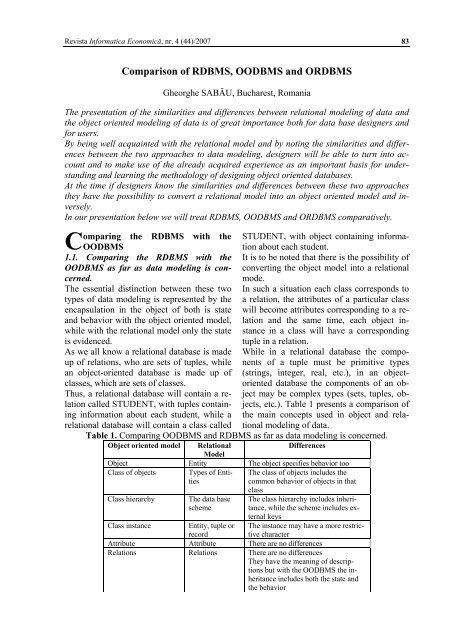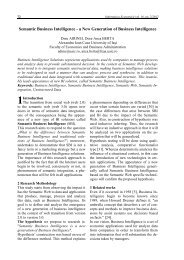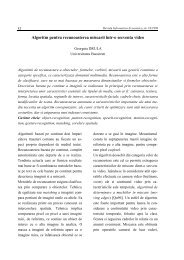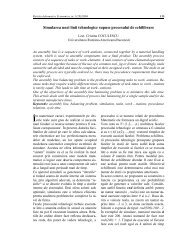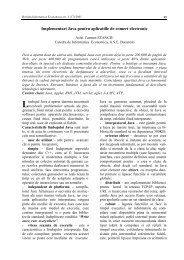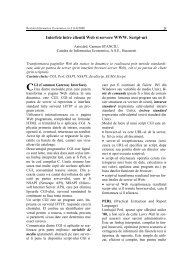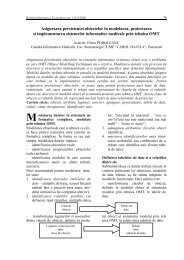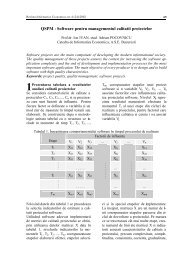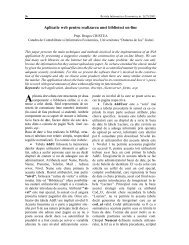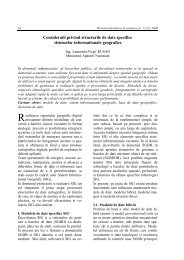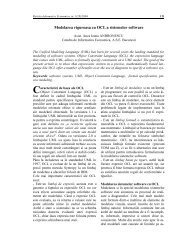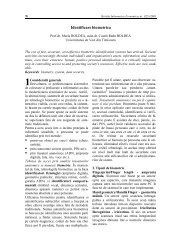Comparison of RDBMS, OODBMS and ORDBMS
Comparison of RDBMS, OODBMS and ORDBMS
Comparison of RDBMS, OODBMS and ORDBMS
You also want an ePaper? Increase the reach of your titles
YUMPU automatically turns print PDFs into web optimized ePapers that Google loves.
Revista Informatica Economică, nr. 4 (44)/2007 83<br />
<strong>Comparison</strong> <strong>of</strong> <strong>RDBMS</strong>, <strong>OODBMS</strong> <strong>and</strong> O<strong>RDBMS</strong><br />
Gheorghe SABĂU, Bucharest, Romania<br />
The presentation <strong>of</strong> the similarities <strong>and</strong> differences between relational modeling <strong>of</strong> data <strong>and</strong><br />
the object oriented modeling <strong>of</strong> data is <strong>of</strong> great importance both for data base designers <strong>and</strong><br />
for users.<br />
By being well acquainted with the relational model <strong>and</strong> by noting the similarities <strong>and</strong> differences<br />
between the two approaches to data modeling, designers will be able to turn into account<br />
<strong>and</strong> to make use <strong>of</strong> the already acquired experience as an important basis for underst<strong>and</strong>ing<br />
<strong>and</strong> learning the methodology <strong>of</strong> designing object oriented databases.<br />
At the time if designers know the similarities <strong>and</strong> differences between these two approaches<br />
they have the possibility to convert a relational model into an object oriented model <strong>and</strong> inversely.<br />
In our presentation below we will treat <strong>RDBMS</strong>, <strong>OODBMS</strong> <strong>and</strong> O<strong>RDBMS</strong> comparatively.<br />
C<br />
omparing the <strong>RDBMS</strong> with the STUDENT, with object containing informa-<br />
<strong>OODBMS</strong><br />
tion about each student.<br />
1.1. Comparing the <strong>RDBMS</strong> with the It is to be noted that there is the possibility <strong>of</strong><br />
<strong>OODBMS</strong> as far as data modeling is con- converting the object model into a relational<br />
cerned.<br />
mode.<br />
The essential distinction between these two In such a situation each class corresponds to<br />
types <strong>of</strong> data modeling is represented by the a relation, the attributes <strong>of</strong> a particular class<br />
encapsulation in the object <strong>of</strong> both is state will become attributes corresponding to a re-<br />
<strong>and</strong> behavior with the object oriented model, lation <strong>and</strong> the same time, each object in-<br />
while with the relational model only the state stance in a class will have a corresponding<br />
is evidenced.<br />
tuple in a relation.<br />
As we all know a relational database is made While in a relational database the compo-<br />
up <strong>of</strong> relations, who are sets <strong>of</strong> tuples, while nents <strong>of</strong> a tuple must be primitive types<br />
an object-oriented database is made up <strong>of</strong> (strings, integer, real, etc.), in an object-<br />
classes, which are sets <strong>of</strong> classes.<br />
oriented database the components <strong>of</strong> an ob-<br />
Thus, a relational database will contain a reject may be complex types (sets, tuples, oblation<br />
called STUDENT, with tuples containjects, etc.). Table 1 presents a comparison <strong>of</strong><br />
ing information about each student, while a the main concepts used in object <strong>and</strong> rela-<br />
relational database will contain a class called tional modeling <strong>of</strong> data.<br />
Table 1. Comparing <strong>OODBMS</strong> <strong>and</strong> <strong>RDBMS</strong> as far as data modeling is concerned.<br />
Object oriented model Relational<br />
Model<br />
Differences<br />
Object Entity The object specifies behavior too<br />
Class <strong>of</strong> objects Types <strong>of</strong> Enti- The class <strong>of</strong> objects includes the<br />
ties<br />
common behavior <strong>of</strong> objects in that<br />
class<br />
Class hierarchy The data base The class hierarchy includes inheri-<br />
scheme tance, while the scheme includes external<br />
keys<br />
Class instance Entity, tuple or The instance may have a more restric-<br />
record<br />
tive character<br />
Attribute Attribute There are no differences<br />
Relations Relations There are no differences<br />
They have the meaning <strong>of</strong> descriptions<br />
but with the <strong>OODBMS</strong> the inheritance<br />
includes both the state <strong>and</strong><br />
the behavior
84<br />
Revista Informatica Economică, nr. 4 (44)/2007<br />
Messages/Interface There are none<br />
Encapsulation There is none<br />
Object identifier (OID) Primary key In the relational model if the primary<br />
key is not identified the system generates<br />
an identifier automatically<br />
Inheritance There is none<br />
1.2. Comparing <strong>RDBMS</strong> with <strong>OODBMS</strong> as<br />
far as their targeted objectives are concerned.<br />
The difference between the <strong>OODBMS</strong> <strong>and</strong><br />
<strong>RDBMS</strong> may be also put into light by con-<br />
sidering their objectives <strong>and</strong> other characteristics<br />
as it can be seen in table 2.<br />
Table 2. Comparing <strong>OODBMS</strong> with <strong>RDBMS</strong> considering their objectives<br />
<strong>OODBMS</strong> <strong>RDBMS</strong><br />
• Main objectives: data encapsulation <strong>and</strong> inde- • Main objective: ensuring data independence from<br />
pendence.<br />
application programs.<br />
• Independence <strong>of</strong> classes: classes can be reorgan- • Data independence: Data can be reorganized <strong>and</strong><br />
ized without affecting the mode <strong>of</strong> using them. modified without affecting the mode <strong>of</strong> using them.<br />
• <strong>OODBMS</strong> store data <strong>and</strong> methods. • <strong>RDBMS</strong> store only data.<br />
• Encapsulation: the data can be used only through • Data partitioning: data can be partitioned depending<br />
their classes’ methods.<br />
on the requirements <strong>of</strong> the users <strong>and</strong> on the specific<br />
users applications.<br />
• Active objects: the objects active. Requests cause • Passive data: the data are passive. Certain opera-<br />
objects to execute their methods.<br />
tions, which are limited, can be automatically brought<br />
into use when the data are used.<br />
• Complexity: the structure <strong>of</strong> data may be com- • Simplicity: users perceive data as columns,<br />
plex, involving different types <strong>of</strong> data.<br />
rows/tuples <strong>and</strong> tables.<br />
• Chained data: data can be chained so that the • Separate Tables: each relation/table is separate. The<br />
methods <strong>of</strong> classes may bring about increased performance.<br />
Structured data such as BLOBS (binary<br />
large objects) are used for sound, image, video etc.<br />
Join Operator refers data from separate tables.<br />
• Non-redundancy <strong>of</strong> methods: data <strong>and</strong> methods • Data non-redundancy: data normalization aims at<br />
non-redundancy is achieved through encapsulation eliminating or reducing data redundancy. It is used in<br />
<strong>and</strong> inheritance. Inheritance helps to reduce the re- the stage <strong>of</strong> designing the database <strong>and</strong> not in the stage<br />
dundancy <strong>of</strong> methods.<br />
<strong>of</strong> developing the applications.<br />
• Optimizing classes: the data for an object can be • <strong>RDBMS</strong> performance is related to the level <strong>of</strong> com-<br />
interrelated <strong>and</strong> stored together, so that they may<br />
all be accessed by the access mechanism.<br />
plexity <strong>of</strong> the data structure.<br />
• Consistent conceptual model: the models used for • Different conceptual model: the model <strong>of</strong> data struc-<br />
analysis, designing, programming <strong>and</strong> accessing ture <strong>and</strong> data access represented by tables <strong>and</strong> JOINS<br />
the database are similar.<br />
is different from the model <strong>of</strong> analysis, designing <strong>and</strong><br />
The classes <strong>of</strong> objects directly represent the con- programming.<br />
cepts <strong>of</strong> applications.<br />
The project must be converted in relational <strong>and</strong> access<br />
tables in accordance with SQL.<br />
2. Comparing the <strong>RDBMS</strong> with the<br />
O<strong>RDBMS</strong><br />
When we compare the <strong>RDBMS</strong> with the<br />
O<strong>RDBMS</strong> the following aspects can be<br />
noted:<br />
• An O<strong>RDBMS</strong> is a relational DBMS<br />
with SQL3 extensions.<br />
• SQL3 extensions include: row types,<br />
user-defined types <strong>and</strong> user-defined routines,<br />
polymorphism, inheritance, reference types<br />
<strong>and</strong> object identity, collection types (AR-<br />
RAYs), new language constructs that make<br />
SQL computationally complete, triggers <strong>and</strong><br />
support for language objects – Binary Large<br />
Objects (BLOBs) <strong>and</strong> Character Large Objects<br />
(CLOBs) – <strong>and</strong> recursion.<br />
• A <strong>RDBMS</strong> is characterized by simplicity<br />
<strong>and</strong> increased stability as compared to<br />
an O<strong>RDBMS</strong>, <strong>and</strong> this fact confers it the<br />
quality <strong>of</strong> being easily used.<br />
• Traditional <strong>RDBMS</strong> use B – tree indexes<br />
to speed access to scalar data. With the<br />
ability to define complex data types in an<br />
O<strong>RDBMS</strong>, specialized index structures are
Revista Informatica Economică, nr. 4 (44)/2007 85<br />
required for efficient to data. Some<br />
O<strong>RDBMS</strong>s are beginning to support additional<br />
index types, such as generic B-trees,<br />
R-trees (region trees) for fast access to two –<br />
<strong>and</strong> three dimensional data, <strong>and</strong> the ability to<br />
index on the output <strong>of</strong> a function.<br />
• A mechanism to plug in any user –<br />
defined index structure provides the highest<br />
level <strong>of</strong> flexibility.<br />
• Both DBMSs are characterized by<br />
simplicity <strong>of</strong> development owing to the fact<br />
that it provides independence <strong>of</strong> data from<br />
applications good for simple relationships.<br />
• For <strong>RDBMS</strong> there is SQL2 st<strong>and</strong>ard<br />
(ANSI X3H2) <strong>and</strong> for O<strong>RDBMS</strong> there is<br />
SQL3 st<strong>and</strong>ard.<br />
• <strong>RDBMS</strong> is a mature s<strong>of</strong>tware product<br />
while O<strong>RDBMS</strong> is an immature product<br />
(extensions are new, thy are still being defined<br />
<strong>and</strong> are relatively unproven.<br />
• As far as the support for object –<br />
oriented programming is concerned, with the<br />
<strong>RDBMS</strong>, programmers spend 25% <strong>of</strong> coding<br />
time mapping the program object to the database,<br />
<strong>and</strong> with the O<strong>RDBMS</strong>, the support for<br />
object-oriented programming is limited<br />
mostly to new data types.<br />
3. Comparing <strong>OODBMS</strong> with O<strong>RDBMS</strong><br />
When we compared <strong>OODBMS</strong> with<br />
O<strong>RDBMS</strong> some conclusions can be drawn.<br />
• <strong>OODBMS</strong>s <strong>and</strong> O<strong>RDBMS</strong>s both<br />
support user-defined ADTs, structured types,<br />
object identity <strong>and</strong> reference types, <strong>and</strong> inheritance;<br />
• They both support a query language<br />
for manipulating collection types;<br />
• O<strong>RDBMS</strong>s support an extended<br />
form <strong>of</strong> SQL, <strong>and</strong> <strong>OODBMS</strong>s support<br />
ODL/OQL;<br />
• O<strong>RDBMS</strong>s consciously try to add<br />
<strong>OODBMS</strong> features to an <strong>RDBMS</strong>, <strong>and</strong><br />
<strong>OODBMS</strong> in their turn have developed query<br />
languages based on relational query languages;<br />
• Both <strong>OODBMS</strong>s <strong>and</strong> O<strong>RDBMS</strong>s<br />
provide DBMS functionality such as concurrency<br />
control <strong>and</strong> recovery;<br />
• <strong>OODBMS</strong>s try to add DBMS functionality<br />
to a programming language,<br />
whereas O<strong>RDBMS</strong>s try to add richer data<br />
types to a relational DBMS.<br />
Conclusions<br />
From the literature we can draw some conclusions<br />
regarding <strong>RDBMS</strong> <strong>and</strong> <strong>OODBMS</strong>:<br />
• Relational databases have as their<br />
objective to ensure data independence. Normalized<br />
data are separated from processing<br />
<strong>and</strong> the processing corresponding to satisfying<br />
informational requirements need not be<br />
totally pre-defined, thus accepting ad-hoc requirements<br />
too.<br />
• Object oriented databases have as<br />
their main objective encapsulation, being<br />
stored together with the data <strong>and</strong> the methods.<br />
They are inseparable. It is said that we<br />
have to do with an independence <strong>of</strong> classes<br />
<strong>and</strong> not with an independence <strong>of</strong> data.<br />
• An <strong>OODBMS</strong> <strong>and</strong> not an <strong>RDBMS</strong><br />
is needed when in the reference applications<br />
we have to do with complex data.<br />
• The object oriented database markets<br />
will continue to develop, but they will<br />
still (represent) only a fraction <strong>of</strong> the traditional<br />
databases.<br />
• It is appreciated that RDMSs hold<br />
the largest part <strong>of</strong> the largest part <strong>of</strong> the databases.<br />
But the prospect is that they will still<br />
co-exist for a long time future with the<br />
OODBS.<br />
References<br />
1. Atkinson M., Bancilhou F. – Object Oriented<br />
Database System Manifest. In Proc. 1st Int. Conf.<br />
Deductive <strong>and</strong> Object Oriented Database, Kyoto,<br />
Japan, 1989.<br />
2. R.G.G. Cattell – Object Data Management.,<br />
Ed. Addison Wesley, 1994.<br />
3. Codd E.F. – Is your DBMS really relational?,<br />
Computerworld, oct the 14th 1985.<br />
4. Codd E.F. – Does your DBMS run by tech<br />
rules?, Computerworld, 21 oct. 1985.<br />
5. C. J. Date – An Introduction to Database Systems.<br />
Eight Edition, Pearson Addison-Wesley,<br />
2004.<br />
6. Thomas Connolly, Carolyn Begg – Database<br />
to Design, Implementation <strong>and</strong> Management.<br />
Fourth Edition, Ed. Addison-Wesley, 2005.


